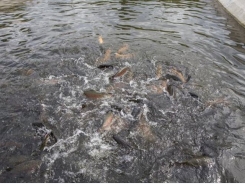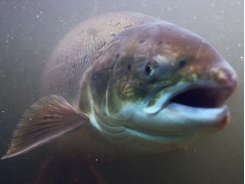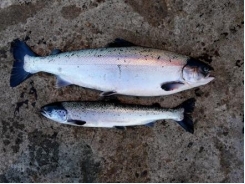Farmed fish dont need to eat fish

Farmed rainbow trout can live well on plant feed. (Photo: Colourbox)
Fish has traditionally been an important ingredient of feed in aquaculture, now new research shows how farmed rainbow trout can eat feed completely free of fishmeal, while growing fast in good health
Fish in the sea are a limited resource. Thus, there will be increasing competition for using the fish in food for humans, farmed fish and farm animals.
The solution for the aquaculture industry is to look for nutrients among plants. Soy, rapeseed, lupines and corn turned out to have good qualities in fish feed.
Today’s fish feeds contain quite a different selection of ingredients than before, and the amount of plants in the feed is growing fast. But this change in feed composition has had side effects.
The side effects are caused by the plant’s own defence mechanisms in the form of antinutrients, and that plants have an unbalanced composition of nutrients seen from the fish’s point of view.
The antinutrients reduce the utilization of nutrients, and may even cause health problems. Furthermore, soy and rapeseed are not appetizing to fish.
The question is: How can we make the plant feed tasty and nutritious, and with minimal side effects?
A fine balance of plants and krill
The Chinese PhD student Yuexing Zhang at the Aquaculture Protein Centre (APC) in Norway shows in his doctoral work how to find the fine balance between antinutrients, nutrient composition and taste.
To remove the antinutrient phytic acid, he treated plant proteins of different origin with an enzyme that breaks down the phytic acid. He used a method developed by APC.
To make the feed nutrient rich, he added essential amino acids, and to make the feed tasty, he added krill meal.
Zhang served the feeds to rainbow trout to see how the fish grew and utilized the feed. He compared the plant-based feed with feed based on fishmeal. Several of the plant protein blends could compare with fishmeal of the highest quality. He got the best result when 95 percent of the protein came from peas, potatoes and rapeseed, with the remainder from krill meal.
Even though a good deal of the fibres were removed from the plant ingredients, they were still harder to digest than fishmeal. Therefore, the fish needed more feed to grow than on fishmeal. Feeds with a large amount of pea protein also led to undesirable reactions in the fish gut.
The scientist saw no other significant side effects from a fishmeal-free diet.
More nutrients to the fish, less to the environment
The best feed with plants was as good as the feed with fishmeal for the rainbow trout. The fish grew well and took up more of the essential nutrients such as phosphorous, calcium and magnesium.
With other protein blends, more of these valuable nutrients went undigested through the digestive system of the rainbow trout, and into the water environment.
The value of the research increases if it can be transferred to other species. Some of the feeds were tested on rainbow trout in Norway and Chinese sea bream in China. Both rainbow trout and sea bream grew well on the different feeds, but the trout utilized the feed more efficiently than the sea bream.
For global use
“This illustrates that knowledge obtained through research on salmonids to some degree can be transferred to other species,” says Trond Storebakken of APC, who is one of Zhang’s supervisors.
“It is important that this kind of knowledge is tested in experiments with the other species, since we know of several examples of species-specific reactions to different ingredients.”
There is plenty of knowledge on salmonids, but salmon and trout are small in global aquaculture.
“When we transfer and adjust knowledge from our research on salmonids to other species, we can contribute to lower the proportion of fishmeal in feed for farmed fish globally,” says Storebakken.
Facts
The research is from the doctoral work of Yuexing Zhang at the Aquaculture Protein Centre (APC) in Norway
Zhang received his degree from the Norwegian University of Life Sciences (UMB) in December 2011
Supervisors were Trond Storebakken, Margareth Øverland and Karl Shearer at APC/UMB
APC conducts research to find new protein sources in feed for farmed fish, and improve utilisation of feed
APC employs scientists from UMB, the Norwegian School of Veterinary Science and Nofima
Có thể bạn quan tâm
Phần mềm

Phối trộn thức ăn chăn nuôi

Pha dung dịch thủy canh

Định mức cho tôm ăn

Phối trộn phân bón NPK

Xác định tỷ lệ tôm sống

Chuyển đổi đơn vị phân bón

Xác định công suất sục khí

Chuyển đổi đơn vị tôm

Tính diện tích nhà kính

Tính thể tích ao hồ




 Watching ocean currents may limit disease spread on…
Watching ocean currents may limit disease spread on…  Coastal streams spread virus between farmed fish
Coastal streams spread virus between farmed fish